今天的学习主要是完成一个购物车项目,该项目中使用servlet完成,对于不知道servlet不知道如何使用的去看servlet的使用该篇文章,该文章中有教大家如何使用servlet。
目录
一.项目所需表
二.购物车项目实操
1.登录操作
2.首页操作
购物车数据操作 :CarServlet, 我们在点击首页的加入购物车页面时,会到该类中进行数据操作,将商品添加进购物车
3.购物车
三.过滤器
一.项目所需表
我们一共需要使用到四张表格,将代码数据提供给到大家,大家直接拿到数据库中运行,四张表格分别是用户表,商品表,订单表,订单详情表。
create table car_user
(
id number primary key,
account varchar2(30) not null,
password varchar(32) not null
);
comment on column car_user.ID is '用户编号';
comment on column car_user.account is '用户账户';
comment on column car_user.password is '用户密码(MD5)';
create table car_goods
(
id number primary key,
name varchar2(20) not null,
describe varchar2(100) default '此商品暂时没有介绍🤣' not null,
price number not null
);
comment on column car_goods.ID is '商品编号';
comment on column car_goods.name is '商品名称';
comment on column car_goods.describe is '商品描述';
comment on column car_goods.price is '用户价格';
create table car_order
(
id number primary key,
user_id number not null,
total number not null
);
comment on column car_order.ID is '订单编号';
comment on column car_order.user_id is '谁的订单!';
comment on column car_order.total is '订单总价';
create table car_order_item
(
id number primary key,
order_id number not null,
goods_id number not null,
quantity number not null,
total number not null
);
comment on column car_order_item.ID is '订单项编号';
comment on column car_order_item.order_id is '哪个订单!';
comment on column car_order_item.goods_id is '哪个商品!';
comment on column car_order_item.quantity is '下单数量';
comment on column car_order_item.total is '订单项总价';
comment on table car_user is '购物车用户表';
comment on table car_goods is '购物车商品表';
comment on table car_order is '购物车订单表';
comment on table car_order_item is '购物车订单项表';
create unique index car_user_account_idx on car_user (account);
insert into car_user
values (1, '2890@fox.com', 'ff9830c42660c1dd1942844f8069b74a');-- root123
insert into car_user
values (2, '2357@fox.com', 'e10adc3949ba59abbe56e057f20f883e');-- 123456
insert into car_goods
select 1, '丝袜奶茶', '冰冰娘娘,很好喝', 99
from dual
union
select 2, '勃勃奶茶', '啊~,好冰冰', 29
from dual
union
select 3, '蜜雪大补丁', '可以加个桃桃🍑', 59
from dual
union
select 4, '臭🐟咖啡', '人气最高', 88
from dual
union
select 5, '雪王咖啡', 'incredible taste', 999
from dual
union
select 6, '拉稀弹筒', '👌,就亿点点', 1
from dual;
insert into car_order_item
values (1, 1, 1, 2, 99 * 2);
insert into car_order_item
values (2, 1, 2, 3, 29 * 3);
insert into car_order_item
values (3, 1, 6, 100, 100);
insert into car_order
values (1, 1, 99 * 2 + 29 * 3 + 100);
insert into car_order_item
values (4, 2, 3, 2, 59 * 2);
insert into car_order_item
values (5, 2, 4, 3, 88 * 3);
insert into car_order_item
values (6, 2, 5, 100, 999 * 100);
insert into car_order
values (2, 2, 59 * 2 + 88 * 3 + 999 * 100);
select *
from car_user;
select *
from car_order;
select *
from car_order_item;
select *
from car_goods;如图所示:
- 订单表中显示的数据,肯定是登录进来的用户他的所有订单数据,一个用户对应着多个订单。
- 订单详情表:对应着订单的编号,商品的编号,我们是根据自己想查看的订单的详细 数据,一个订单对应着多件商品。

二.购物车项目实操
该购物车我们具备登录,首页,将商品加入购物车,购物车界面,在实操的时候首先我们需要把需要的包导进去。

文件放置位置

1.登录操作
思路:
- 登录界面具备的方法就是去到数据库查询用户是否存在,如果用户存在我们就跳转到首页去
pojo包下的用户实体类代码如下: User
package com.yjx.pojo;
/**
* 用户实体类
* @author zjjt
*
*/
public class User {
private Integer id;
private String name;
private String pwd;
public Integer getId() {
return id;
}
public void setId(Integer id) {
this.id = id;
}
public String getName() {
return name;
}
public void setName(String name) {
this.name = name;
}
public String getPwd() {
return pwd;
}
public void setPwd(String pwd) {
this.pwd = pwd;
}
public User() {
// TODO Auto-generated constructor stub
}
public User(Integer id, String name, String pwd) {
super();
this.id = id;
this.name = name;
this.pwd = pwd;
}
@Override
public String toString() {
return "User [id=" + id + ", name=" + name + ", pwd=" + pwd + "]";
}
}
用户数据库访问层接口代码如下: IUserDao
package com.yjx.dao;
/**
* 用户数据访问层接口
* @author zjjt
*
*/
import com.yjx.pojo.User;
public interface IUserDao {
//登录验证
User login(User u);
}
用户数据库访问层代码如下: 该类中具备登录验证的方法 UserDaoImpl
package com.yjx.dao.impl;
import java.sql.Connection;
import java.sql.PreparedStatement;
import java.sql.ResultSet;
import com.yjx.dao.IUserDao;
import com.yjx.pojo.User;
import com.yjx.util.DBHeper;
public class UserDaoImpl implements IUserDao {
private Connection con;
private PreparedStatement ps;
private ResultSet rs;
/**
* 登录验证方法
*/
@Override
public User login(User u) {
try {
con=DBHeper.getCon();
ps=con.prepareStatement("select * from car_user where account=?");
ps.setString(1, u.getName());
rs=ps.executeQuery();
if(rs.next()) {
User user=new User();
user.setId(rs.getInt(1));
user.setName(rs.getString(2));
user.setPwd(rs.getString(3));
return user;
}
} catch (Exception e) {
e.printStackTrace();
}
return null;
}
}
用户业务逻辑层接口代码如下:IUserBiz
package com.yjx.biz;
import com.yjx.pojo.User;
public interface IUserBiz {
//登录验证方法
User login(User u);
}
用户业务逻辑层代码如下:UserBizImpl
package com.yjx.biz.impl;
import org.apache.commons.codec.digest.DigestUtils;
import com.yjx.biz.IUserBiz;
import com.yjx.dao.IUserDao;
import com.yjx.dao.impl.UserDaoImpl;
import com.yjx.pojo.User;
public class UserBizImpl implements IUserBiz {
IUserDao userdao=new UserDaoImpl();
/**
* 登录验证方法
*/
@Override
public User login(User u) {
User user=userdao.login(u);
String pwd=DigestUtils.md5Hex(u.getPwd());
if(user.getPwd().equals(pwd)) {
return user;
}
return null;
}
}登录页面代码:login.jsp
<%@ page language="java" contentType="text/html; charset=UTF-8"
pageEncoding="UTF-8"%>
<!DOCTYPE html>
<html><head><meta http-equiv="Content-Type" content="text/html; charset=UTF-8">
<link rel="stylesheet" href="bootstrap-3.3.7-dist/css/bootstrap.css">
<script src="bootstrap-3.3.7-dist/js/jquery-3.5.1.js"></script>
<script src="bootstrap-3.3.7-dist\js\bootstrap.js"></script>
<meta name="viewport" content="width=device-width,initial-scale=1">
<title>登录界面</title>
<style>
form {
width: 500px;
margin:auto;
}
</style>
</head>
<body>
<form action="login.do" method="post">
<h1>登录</h1>
<div class="form-group">
<input name="uname" class="form-control" placeholder="用户名">
</div>
<div class="form-group">
<input name="upwd" class="form-control" placeholder="密码">
</div>
<div class="form-group">
<button class="btn btn-primary btn-block">登录</button>
</div>
</form>
</body></html>实现登录功能代码如下 : LoginServlet
在这里我们将用户存进session中,当用户一进来我们就给用户一个购物车,该购物车中存放我们在首页加入购物车的商品,然后在购物车界面遍历。
package com.yjx.servlet;
import java.io.IOException;
import java.util.ArrayList;
import java.util.List;
import javax.servlet.ServletException;
import javax.servlet.annotation.WebServlet;
import javax.servlet.http.HttpServlet;
import javax.servlet.http.HttpServletRequest;
import javax.servlet.http.HttpServletResponse;
import com.yjx.biz.IGoodsBiz;
import com.yjx.biz.IUserBiz;
import com.yjx.biz.impl.GoodsBizImpl;
import com.yjx.biz.impl.UserBizImpl;
import com.yjx.pojo.Car;
import com.yjx.pojo.User;
/**
* 实现登录功能
* @author zjjt
*
*/
@WebServlet("/login.do")
public class LoginServlet extends HttpServlet{
IUserBiz userbiz=new UserBizImpl();
IGoodsBiz goodsbiz=new GoodsBizImpl();
@Override
protected void doGet(HttpServletRequest req, HttpServletResponse resp) throws ServletException, IOException {
doPost(req,resp);
}
@Override
protected void doPost(HttpServletRequest req, HttpServletResponse resp) throws ServletException, IOException {
req.setCharacterEncoding("utf-8");
String name=req.getParameter("uname");
String pwd=req.getParameter("upwd");
User u=new User(0,name,pwd);
userbiz.login(u);
if(u!=null) {
//将用户存入session中
req.getSession().setAttribute("user", u);
//进来的时候就给该用户一个购物车,将该购物车存在session中
List<Car> car=new ArrayList<Car>();
req.getSession().setAttribute("car",car);
//总价
req.getSession().setAttribute("sum", 0);
//跳转到实现首页功能
resp.sendRedirect("index.do");
}else {
resp.sendRedirect("login.jsp");
}
}
}
2.首页操作
思路:
- 首页界面需要显示商品表中的数据
- 点击加入购物车将数据加入进购物车
商品表的pojo包下的商品实体类代码如下:Goods
package com.yjx.pojo;
/**
* 商品实体类
* @author zjjt
*
*/
public class Goods {
private Integer id;
private String name;
private String describe;
private Integer price;
public Integer getId() {
return id;
}
public void setId(Integer id) {
this.id = id;
}
public String getName() {
return name;
}
public void setName(String name) {
this.name = name;
}
public String getDescribe() {
return describe;
}
public void setDescribe(String describe) {
this.describe = describe;
}
public Integer getPrice() {
return price;
}
public void setPrice(Integer price) {
this.price = price;
}
public Goods() {
// TODO Auto-generated constructor stub
}
public Goods(Integer id, String name, String describe, Integer price) {
super();
this.id = id;
this.name = name;
this.describe = describe;
this.price = price;
}
@Override
public String toString() {
return "Goods [id=" + id + ", name=" + name + ", describe=" + describe + ", price=" + price + "]";
}
}
商品数据访问层接口: IGoodsDao
package com.yjx.dao;
import java.util.List;
import com.yjx.pojo.Goods;
/**
* 商品数据访问层的接口
* @author zjjt
*
*/
public interface IGoodsDao {
//查询商品表中的所有数据
List<Goods> selectAll();
//根据id查询
Goods selestId(int id);
}
商品数据访问代码如下: GoodsDaoImpl
package com.yjx.dao.impl;
import java.sql.Connection;
import java.sql.PreparedStatement;
import java.sql.ResultSet;
import java.util.ArrayList;
import java.util.List;
import com.yjx.dao.IGoodsDao;
import com.yjx.pojo.Goods;
import com.yjx.util.DBHeper;
/**
* 商品数据访问层
* @author zjjt
*
*/
public class GoodsDaoImpl implements IGoodsDao{
private Connection con;
private PreparedStatement ps;
private ResultSet rs;
/**
* 查询商品表中的所有数据
*/
@Override
public List<Goods> selectAll() {
List<Goods> list=new ArrayList<Goods>();
try {
con=DBHeper.getCon();
ps=con.prepareStatement("select * from car_goods");
rs=ps.executeQuery();
while(rs.next()) {
Goods g=new Goods();
g.setId(rs.getInt(1));
g.setName(rs.getString(2));
g.setDescribe(rs.getString(3));
g.setPrice(rs.getInt(4));
list.add(g);
}
} catch (Exception e) {
e.printStackTrace();
}finally {
DBHeper.getColes(con, ps, rs);
}
return list;
}
/**
* 根据商品id进行查询
*/
@Override
public Goods selestId(int id) {
try {
con=DBHeper.getCon();
ps=con.prepareStatement("select * from car_goods where id=?");
ps.setInt(1, id);
rs=ps.executeQuery();
if(rs.next()) {
Goods g=new Goods();
g.setId(rs.getInt(1));
g.setName(rs.getString(2));
g.setDescribe(rs.getString(3));
g.setPrice(rs.getInt(4));
return g;
}
} catch (Exception e) {
e.printStackTrace();
}finally {
DBHeper.getColes(con, ps, rs);
}
return null;
}
}
商品数据业务逻辑层接口代码如下:IGoodsBiz
package com.yjx.biz;
import java.util.List;
import com.yjx.pojo.Goods;
/**
* 商品业务逻辑层接口
* @author zjjt
*
*/
public interface IGoodsBiz {
//查询商品表中的所有数据
List<Goods> selectAll();
//根据id查询
Goods selestId(int id);
}
商品数据业务逻辑层代码如下: GoodsBizImpl
package com.yjx.biz.impl;
import java.util.List;
import com.yjx.biz.IGoodsBiz;
import com.yjx.dao.IGoodsDao;
import com.yjx.dao.impl.GoodsDaoImpl;
import com.yjx.pojo.Goods;
/**
* 商品业务逻辑层
* @author zjjt
*
*/
public class GoodsBizImpl implements IGoodsBiz{
IGoodsDao dao=new GoodsDaoImpl();
/**
* 查询商品表中所有数据
*/
@Override
public List<Goods> selectAll() {
return dao.selectAll();
}
/**
* 根据id查询
*/
@Override
public Goods selestId(int id) {
return dao.selestId(id);
}
}
商品数据操作代码如下: 所以登录成功后先跳转到这里,在将商品数据从全查出来,然后存进session中,在首页的时候在遍历 IndexServlet
package com.yjx.servlet;
import java.io.IOException;
import java.util.ArrayList;
import java.util.List;
import javax.servlet.ServletException;
import javax.servlet.ServletRequest;
import javax.servlet.annotation.WebServlet;
import javax.servlet.http.HttpServlet;
import javax.servlet.http.HttpServletRequest;
import javax.servlet.http.HttpServletResponse;
import com.yjx.biz.IGoodsBiz;
import com.yjx.biz.impl.GoodsBizImpl;
import com.yjx.pojo.Goods;
/**
* 首页商品数据显示
* @author zjjt
*
*/
@WebServlet("/index.do")
public class IndexServlet extends HttpServlet{
@Override
protected void doGet(HttpServletRequest req, HttpServletResponse resp) throws ServletException, IOException {
doPost(req, resp);
}
@Override
protected void doPost(HttpServletRequest req, HttpServletResponse resp) throws ServletException, IOException {
IGoodsBiz goodsbiz=new GoodsBizImpl();
List<Goods> list=goodsbiz.selectAll();
//将该集合中的数据存进request中
req.setAttribute("goods", list);
//使用request存放,需要转发
req.getRequestDispatcher("index.jsp").forward(req, resp);
}
}
首页界面代码如下:index.jsp
<%@ page language="java" contentType="text/html; charset=UTF-8"
pageEncoding="UTF-8"%>
<%@taglib prefix="c" uri="http://java.sun.com/jsp/jstl/core" %>
<!-- 商品首页 -->
<!DOCTYPE html>
<html>
<head><meta http-equiv="Content-Type" content="text/html; charset=UTF-8">
<link rel="stylesheet" href="bootstrap-3.3.7-dist/css/bootstrap.css">
<script src="bootstrap-3.3.7-dist/js/jquery-3.5.1.js"></script>
<script src="bootstrap-3.3.7-dist\js\bootstrap.js"></script>
<meta name="viewport" content="width=device-width,initial-scale=1">
<style>
body {
padding: 20px 40px;
}
</style>
</head>
<body>
<h1>
${user.name}<small>这是首页</small>
</h1>
<h1>
<a class="btn btn-primary" href="car.jsp">点我去购物车🛒</a>
</h1>
<table class="table table-bordered table-striped">
<tbody><tr>
<th>商品编号</th>
<th>商品名称</th>
<th>商品价格</th>
<th>商品操作</th>
</tr>
<!-- 遍历 -->
<c:forEach items="${goods}" var="g">
<tr>
<td>${g.id}</td>
<td>${g.name}</td>
<td>${g.price}</td>
<td><a href="car.do?id=${g.id}" class="btn btn-default">加入🚗</a></td>
</tr>
</c:forEach>
</body></html>购物车数据操作 :CarServlet, 我们在点击首页的加入购物车页面时,会到该类中进行数据操作,将商品添加进购物车
package com.yjx.servlet;
import java.io.IOException;
import java.util.List;
import javax.servlet.ServletException;
import javax.servlet.annotation.WebServlet;
import javax.servlet.http.HttpServlet;
import javax.servlet.http.HttpServletRequest;
import javax.servlet.http.HttpServletResponse;
import com.yjx.biz.IGoodsBiz;
import com.yjx.biz.impl.GoodsBizImpl;
import com.yjx.pojo.Car;
import com.yjx.pojo.Goods;
/**
* 购物车数据
* @author zjjt
*
*/
@WebServlet("/car.do")
public class CarServlet extends HttpServlet{
IGoodsBiz goodsbiz=new GoodsBizImpl();
@Override
protected void doGet(HttpServletRequest req, HttpServletResponse resp) throws ServletException, IOException {
doPost(req, resp);
}
@Override
protected void doPost(HttpServletRequest req, HttpServletResponse resp) throws ServletException, IOException {
List<Car> car=(List<Car>)req.getSession().getAttribute("car");
//先将传过来的id接收到
int id=Integer.parseInt(req.getParameter("id"));
boolean f=true;
//判断该商品是否已经存在购物车中,如何存在只在数量上相加
for (Car c : car) {
if(c.getGoods().getId()==id) {
//设置数量加1
c.setCount(c.getCount()+1);
//设置商品总价
c.setTotal(c.getCount()*c.getGoods().getPrice());
f=false;
break;
}
}
if(f) {
//当商品不存在相同的进入这里
//根据id进行查询商品
Goods goods=goodsbiz.selestId(id);
Car c=new Car();
c.setGoods(goods);
//商品的数量设置
c.setCount(1);
//商品的总价设置
c.setTotal(c.getGoods().getPrice());
car.add(c);
}
//遍历购物车将总价加上
int sum=0;
for (Car car2 : car) {
sum+=car2.getTotal();
}
req.getSession().setAttribute("sum",sum);
resp.sendRedirect("index.do");
}
}3.购物车
购物车中具备查看我们加入购物和的商品,然后对商品的数量增加减,当商品存在购物车中了,我们在首页将同一件商品在加入购物车时,只有数量加1。
购物车的pojo包下的实体类代码如下:Car
package com.yjx.pojo;
/**
* 购物车实体类
* @author zjjt
*
*/
public class Car {
private Goods goods;
private Integer count;
private Integer total;
public Goods getGoods() {
return goods;
}
public void setGoods(Goods goods) {
this.goods = goods;
}
public Integer getCount() {
return count;
}
public void setCount(Integer count) {
this.count = count;
}
public Integer getTotal() {
return total;
}
public void setTotal(Integer total) {
this.total = total;
}
public Car() {
// TODO Auto-generated constructor stub
}
public Car(Goods goods, Integer count, Integer total) {
super();
this.goods = goods;
this.count = count;
this.total = total;
}
}
购物车页面代码如下: car.jsp
<%@ page language="java" contentType="text/html; charset=UTF-8"
pageEncoding="UTF-8"%>
<%@taglib prefix="c" uri="http://java.sun.com/jsp/jstl/core"%>
<!DOCTYPE html>
<html><head><meta http-equiv="Content-Type" content="text/html; charset=UTF-8">
<link rel="stylesheet" href="bootstrap-3.3.7-dist/css/bootstrap.css">
<script src="bootstrap-3.3.7-dist/js/jquery-3.5.1.js"></script>
<script src="bootstrap-3.3.7-dist\js\bootstrap.js"></script>
<meta name="viewport" content="width=device-width,initial-scale=1">
<title>我的购物车</title>
</head>
<body>
<div class="container">
<h1>
${user.name}<small>这是购物车</small>
</h1>
<h1>
<button onclick="location.href='index.do'" class="btn btn-default">继续购买</button>
<button onclick="location.href='calc.do'" class="btn btn-default">订单结算</button>
<button onclick="location.href='myOrder.do'" class="btn btn-default">查看订单</button>
</h1>
<table class="table table-bordered table-striped">
<tr>
<td>商品编号</td>
<td>商品名字</td>
<td>商品单价</td>
<td>商品数量</td>
<td>商品总价</td>
<td>商品操作</td>
</tr>
<c:forEach items="${car}" var="c">
<tr>
<td>${c.goods.id}</td>
<td>${c.goods.name}</td>
<td>${c.goods.price}</td>
<td><a href="updCar.do?id=${c.goods.id}&type=1" class="btn btn-default">+</a> ${c.count} <a href="updCar.do?id=${c.goods.id}&type=-1" class="btn btn-default">-</a></td>
<td>${c.total}</td>
<td><a href="delCar.do?id=${c.goods.id}" class="btn btn-default">商品删除</a></td>
</tr>
</c:forEach>
</table>
</div>
<h1>总价:${sum}</h1>
</body></html>点击加号或者减号数据操作代码如下:updCarServlet
当点击加号或者减号携带过来一个数,判断是加法还是减法,进行对数量上的加减
package com.yjx.servlet;
import java.io.IOException;
import java.util.ArrayList;
import java.util.List;
import javax.servlet.ServletException;
import javax.servlet.annotation.WebServlet;
import javax.servlet.http.HttpServlet;
import javax.servlet.http.HttpServletRequest;
import javax.servlet.http.HttpServletResponse;
import com.yjx.biz.IGoodsBiz;
import com.yjx.biz.impl.GoodsBizImpl;
import com.yjx.pojo.Car;
import com.yjx.pojo.Goods;
/**
* 修改商品数量操作
* @author zjjt
*
*
*/
@WebServlet("/updCar.do")
public class updCarServlet extends HttpServlet{
@Override
protected void doGet(HttpServletRequest req, HttpServletResponse resp) throws ServletException, IOException {
doPost(req, resp);
}
@Override
protected void doPost(HttpServletRequest req, HttpServletResponse resp) throws ServletException, IOException {
//拿到购物车
List<Car> car=(List<Car>)req.getSession().getAttribute("car");
//接收到传过来的值
int id=Integer.parseInt(req.getParameter("id"));
int type=Integer.parseInt(req.getParameter("type"));
for (Car c : car) {
if(c.getGoods().getId().equals(id)) {
int count=c.getCount()+type;
//设置该商品的数量
if(count<1)break;
c.setCount(count);
c.setTotal(c.getCount()*c.getGoods().getPrice());
}
}
//遍历购物车将总价加上
int sum=0;
for (Car car2 : car) {
sum+=car2.getTotal();
}
req.getSession().setAttribute("sum",sum);
resp.sendRedirect("car.jsp");
}
}
购物车数据删除代码如下: delCarServlet
package com.yjx.servlet;
import java.io.IOException;
import java.util.List;
import javax.servlet.ServletException;
import javax.servlet.annotation.WebServlet;
import javax.servlet.http.HttpServlet;
import javax.servlet.http.HttpServletRequest;
import javax.servlet.http.HttpServletResponse;
import com.yjx.pojo.Car;
/**
* 删除商品操作
* @author zjjt
*
*/
@WebServlet("/delCar.do")
public class delCarServlet extends HttpServlet{
@Override
protected void doGet(HttpServletRequest req, HttpServletResponse resp) throws ServletException, IOException {
doPost(req, resp);
}
@Override
protected void doPost(HttpServletRequest req, HttpServletResponse resp) throws ServletException, IOException {
//拿到购物车
List<Car> car=(List<Car>)req.getSession().getAttribute("car");
//先接收到id
int id=Integer.parseInt(req.getParameter("id"));
Car i=null;
//遍历购物车
for (Car c : car) {
if(c.getGoods().getId().equals(id)){
i=c;
}
}
//将商品删除
car.remove(i);
//遍历购物车将总价加上
int sum=0;
for (Car car2 : car) {
sum+=car2.getTotal();
}
req.getSession().setAttribute("sum",sum);
resp.sendRedirect("car.jsp");
}
}
三.过滤器
过滤器的作用,就是当我们没有登录时,有一些界面无法进入,所以我们进在过滤器中进行过滤,满足我们条件的我们就放行,不满足条件的就让他继续在登录页面。文章来源:https://www.toymoban.com/news/detail-441131.html
package com.yjx.filter;
import java.io.IOException;
import java.util.ArrayList;
import java.util.List;
import javax.servlet.Filter;
import javax.servlet.FilterChain;
import javax.servlet.ServletException;
import javax.servlet.ServletRequest;
import javax.servlet.ServletResponse;
import javax.servlet.http.HttpServletRequest;
import javax.servlet.http.HttpServletResponse;
import com.yjx.pojo.User;
/**
* 过滤
* @author zjjt
*
*/
public class LoginFilter implements Filter{
//过滤的作用:因为当我们没有登录成功时,只有允许在登录界面,不允许跳转到别的界面,所以我们选择使用过滤,不满足我们进入的
// 需求就让他跳回登录界面。
//1.先实现filter接口
//2.先实例一个集合,将我们需要放行的页面放入
List<String> list=new ArrayList();
{
list.add("/login.jsp");
list.add("/login.do");
list.add(".css");
list.add(".js");
}
@Override
public void doFilter(ServletRequest req, ServletResponse reps, FilterChain chain)throws IOException, ServletException {
//将请求和响应强转成它的子类
HttpServletRequest request=(HttpServletRequest)req;
HttpServletResponse response=(HttpServletResponse)reps;
//获取到路径
String path=request.getServletPath();
boolean f=false;
//遍历集合和获取到的路径进行判断
for(String p:list) {
if(path.endsWith(p)){//判断是否是以增加进集合的的数据结尾的
//如果以该为结尾的话
f=true;
System.out.print(f);
break;
}
}
if(f){
//如果存在list集合中就放行
chain.doFilter(request, response);//放行语句
return;
}
//判断用户是否已经登录啦,如果session中存在user那么就放行
User u=(User)request.getAttribute("user");//得到一个用户进行判断
if(u!=null) {
chain.doFilter(request, response);
}else {
//用户没有登录就返回登录界面
response.sendRedirect("login.jsp");
}
}
}
今天的学习就到这里啦。文章来源地址https://www.toymoban.com/news/detail-441131.html
到了这里,关于JavaWeb 购物车项目(一)的文章就介绍完了。如果您还想了解更多内容,请在右上角搜索TOY模板网以前的文章或继续浏览下面的相关文章,希望大家以后多多支持TOY模板网!

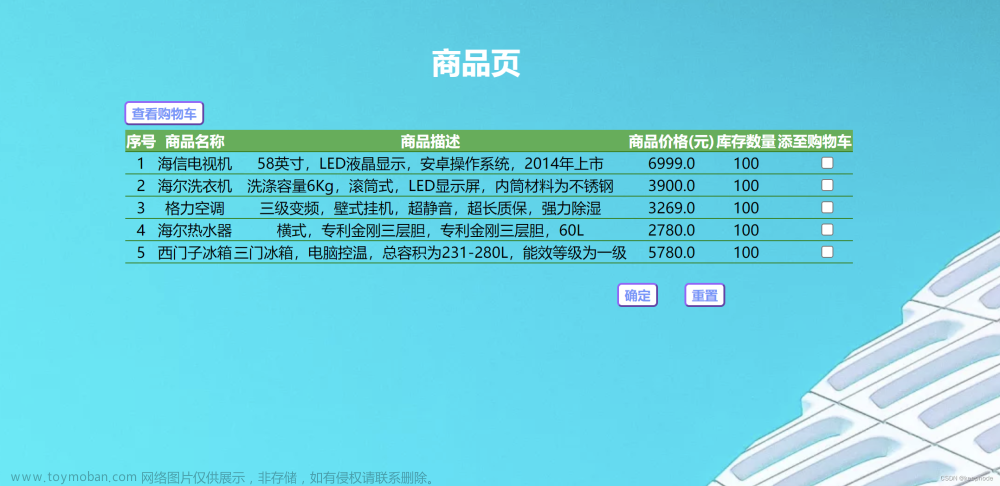

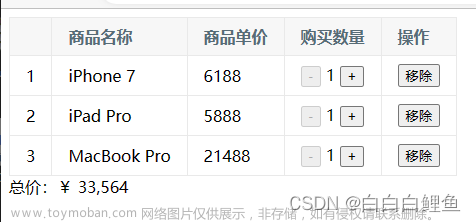

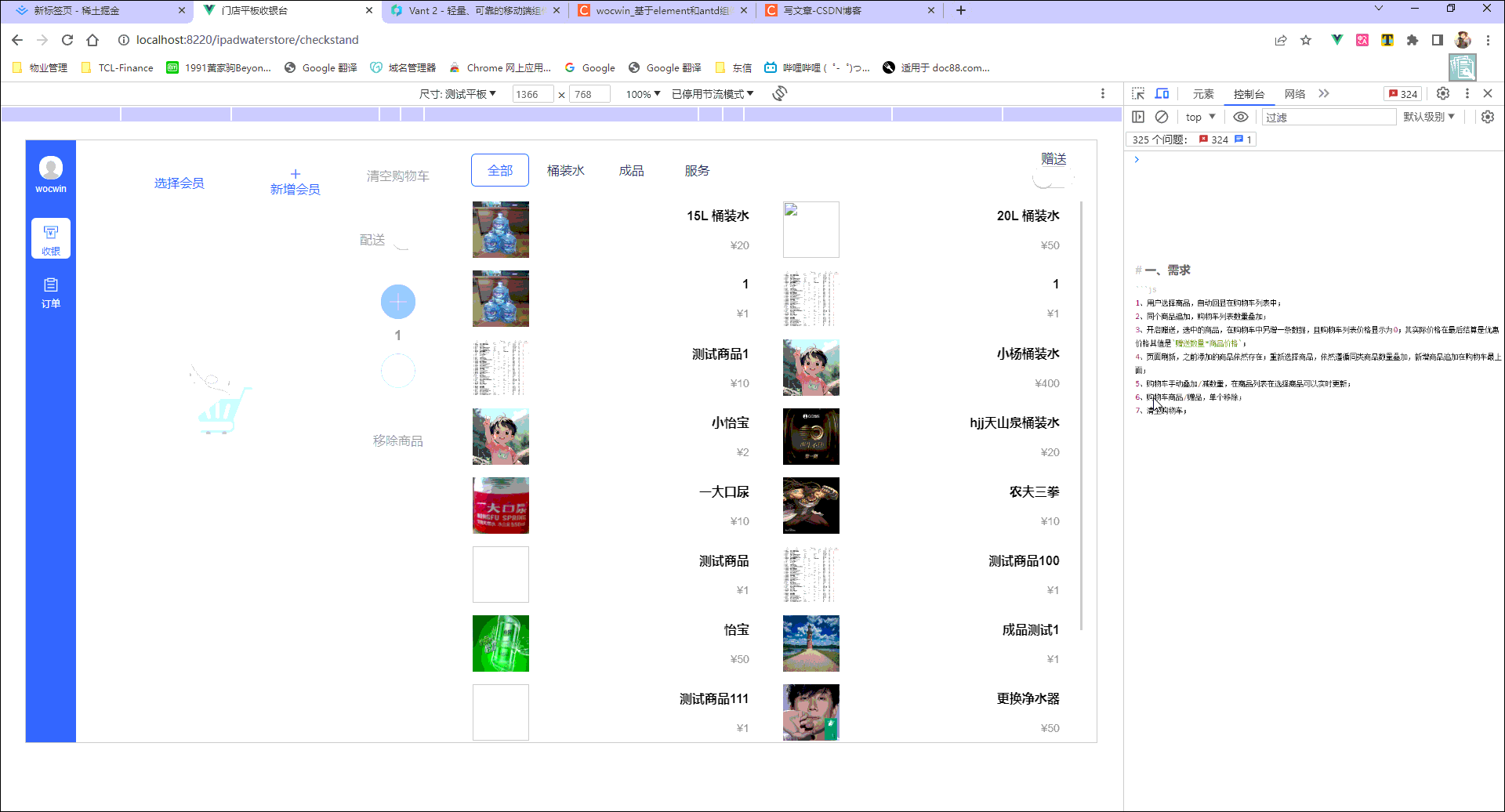
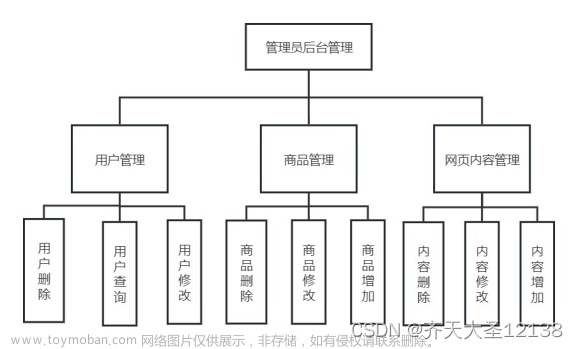
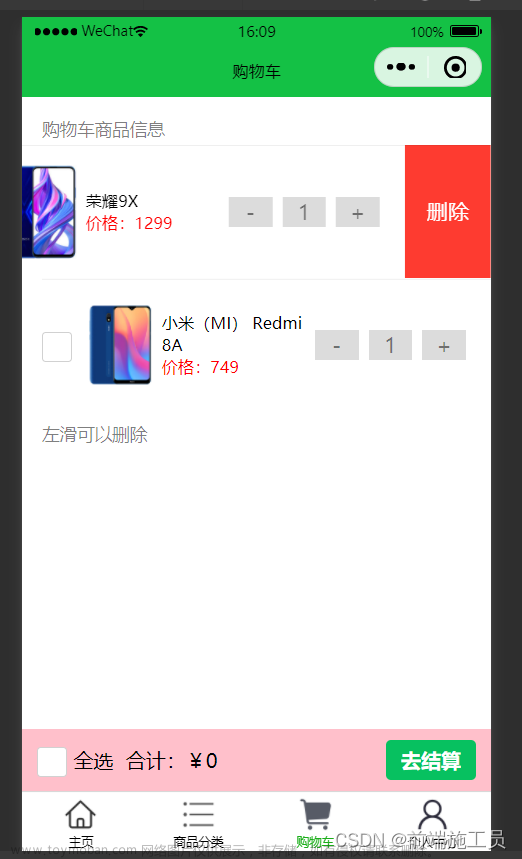
![【java】【项目实战】[外卖八]产品展示、购物车、下单开发](https://imgs.yssmx.com/Uploads/2024/02/681793-1.png)



